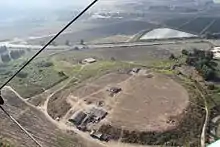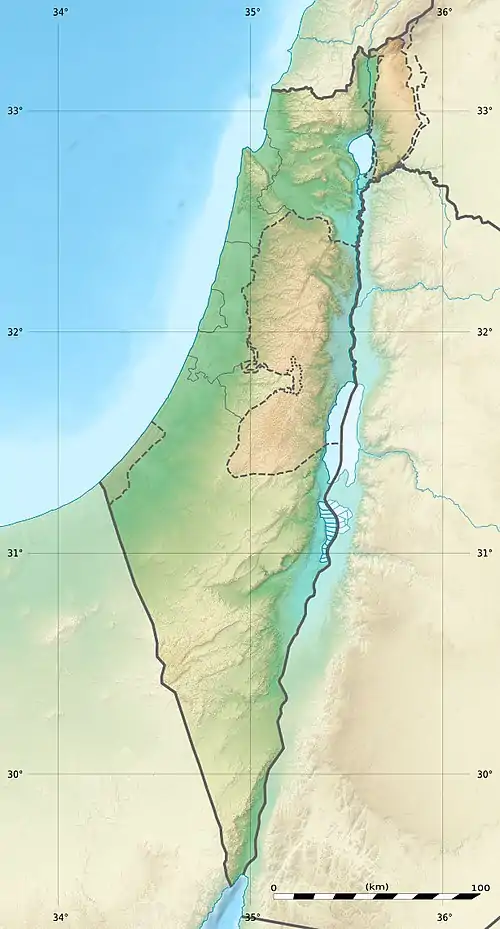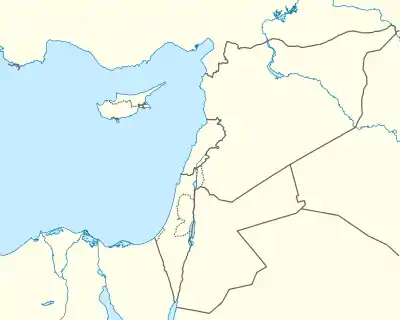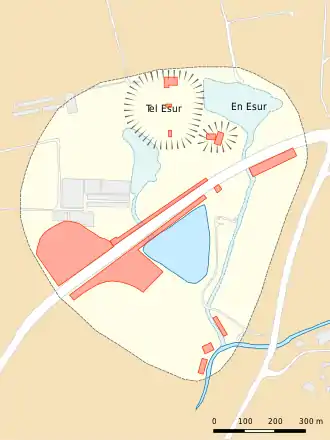En Esur
En Esur (Hebrew: עין אֵסוּר; [ʕen ʔsuʁ] eh-N eh-s-oor) or Ein Asawir (Arabic: عين الأساور, lit. 'Spring of the Braceletes') is an ancient site located in the northern Sharon Plain in the Israeli Coastal Plain. The site includes an archaeological mound (tell), called Tel Esur or Tell el-Asawir, another unnamed mound, and two springs, one of which gives the site its name. During the Early Bronze Age, around 3000 BCE, a massive fortified proto-city with an estimated population of 5,000 to 6,000 inhabitants existed there. It was the largest city in the region, larger than other significant sites such as Tel Megiddo and Tel Jericho, but smaller than other distant sites. The city was discovered in 1977 during a salvage excavation in the site of a future water reservoir, but its massive extent was realized only during excavations in 1993. A major excavation was conducted between 2017 and 2019 ahead of the construction of a new highway interchange for the new town of Harish exposed the city's houses, streets and public structures, as well as countless pottery, tools and artifacts. An even earlier settlement with a 7,000 year-old temple was discovered below the ruins of the Bronze Age city.
עין אֵסוּר | |
 Aerial photo of Tel Esur in the foreground with En Esur to the left, Highway 65 in the middleground, and Barkai in the background | |
 En Esur Shown in Israel  En Esur En Esur (Eastern Mediterranean) | |
| Alternative name | Ein Asawir |
|---|---|
| Location | Menashe, Haifa, Israel |
| Region | Canaan, Southern Levant |
| Coordinates | 32°28′55″N 35°1′10″E |
| Type | Proto-city |
| Area | 50 ha (120 acres) |
| History | |
| Founded | temple c. 5000 BCE; most of city c. 3000 BCE |
| Abandoned | Early Bronze Age I[1] |
| Periods | Pottery Neolithic–Early Bronze Age I[1] |
| Cultures | Canaanites |
| Associated with | 6,000 occupants |
| Site notes | |
| Archaeologists |
|
Archaeologists Itai Elad and Yitzhak Paz announced the discovery of the city in 2019, calling it the "New York City of the early Bronze Age".[2]
Discovery
.jpg.webp)
Tel Esur was known locally as a Tell el-Asawir. It appears in a map drawn by French geographer Pierre Jacotin from 1799.[3] American archaeologist and biblical scholar William F. Albright visited the site during his 1923 trip to Mandatory Palestine. He recalled the opinion of German scholar Albrecht Alt that Tel Esur is the site of an ancient city called "Yaham", mentioned in the sources of the 15th century BCE Egyptian pharaoh Thutmose III, who campaigned against a coalition of Canaanite city-states, led by the king of Kadesh in Megiddo, located just north of the Menashe Heights. According to the Egyptian account, Thutmose III camped in Yaham before he marched on Megiddo to fight the Battle of Megiddo. Albright stated that the location of the site corresponds with the geographic descriptions of the Egyptian sources, and his discovery of Bronze Age pottery while surveying the mound further confirmed this identification in his opinion.[4] Today however, Yaham is identified with a site located in Kafr Yama in Zemer, some 10 kilometers south of Tel Esur.[5]
The discovery of the larger site around Tel Esur and its springs occurred in 1977, when during the digging of a water reservoir south of the mound. A salvage excavation was conducted by archaeologists Azriel Zigelman and Ram Gofna of the Tel Aviv University. They discovered two settlement layers, one from the Chalcolithic period (the last period of the Stone Age) and the Early Bronze Age. The former included the foundations of structures made of rough stones and some installations. These are dated to the early Chalcolithic (c. 6000 years ago). The latter included the foundations of massive structures made of large stones. The widest wall measured 1.7 meters wide. The pottery there is dated to the Early Bronze Age I period (3300–3000 BCE).[6]
A survey and an excavation was conducted in 1993 by Eli Yanai of the Israel Antiquities Authority. It revealed the massive extent of the site during the Early Bronze Age, as well as settlement remains from the Neolithic and Chalcolithic periods, and sherds from the Byzantine and Ottoman periods.[7]
En Esur was excavated by professional and volunteer archaeologists over two and a half years beginning in January 2017, with the research overseen by archaeologists Itai Elad and Yitzhak Paz.[1][8] The work was organized in part by the Israel Antiquities Authority and financed by Netivei Israel, Israel's national transportation infrastructure company.[1][8] During the process of excavation, archaeologists found a temple within the city that was built approximately 2,000 years before the rest of the site.[8]
In an announcement of their discovery, researchers called En Esur "cosmopolitan" and the "New York City of the early Bronze Age".[2]
Site

The site of En Esur is made of three elements: Tel Esur, which is a mound of accumulated human settlement layers, a smaller mound south of the tel, and an open field that surrounds the mounds, where during the Early Bronze Age, a massive city lied. The site is supported by two abundant water springs. The first gives the site its name, En Esur, which is also called En Arubot. The other is unnamed.[7] The springs receive their water an outlet of the 'Iron stream (Wadi Ara), which flows from the modern city of Umm al-Fahm into the Hadera Stream and from there to the Mediterranean Sea.[1]
En Esur occupied a space of around 0.65 square kilometers (160 acres) and may have had 5,000 to 6,000 inhabitants.[11] This would have made the settlement much larger than Tel Megiddo in Israel and Jericho in the West Bank, and therefore the largest settlement in the Southern Levant during this period, but smaller than more distant cities in Egypt and Mesopotamia.[8][12][13] Archaeologist Itai Elad stated that En Esur is double the size of other large settlements known in the area.[14]
The settlement is believed to have existed at the crossroads of two important trading routes.[15] Archaeologists excavating the site believe that the city was planned, and included not only streets, alleys and squares, but also facilities for storage and drainage, and a cemetery.[16][14] En Esur was surrounded by fortified walls that were 2 metres (6.6 feet) high.[17][14] Its discoverers have called the city a "megalopolis".[17]
The site includes about four million artefacts overall, with millions of potsherds and flint tools, and some basalt stone vessels.[8][17][13] The inhabitants of En Esur are thought to have been an agricultural people. They would have traded with other regions and kingdoms.[16] Sealed imprints on tools demonstrate that these were brought to the city from Egypt.[17]
The temple found within the city is estimated to be 7,000 years old, dating from the Chalcolithic period.[14] The temple, which is located in a public area of the city, includes a courtyard with a huge stone basin for rituals, and figurines including a human head and a person next to an animal.[17] Burned animal bones were found inside the temple, providing evidence of possible ritual sacrifices.[17]
Researchers excavating the site have said that it demonstrates early processes of urbanization within Canaanite civilization,[14] and that the city would have probably possessed a substantial "administrative mechanism."[2] Haaretz described the site as "vastly bigger than anything thought possible in the Southern Levant 5,000 years ago."[12] The settlement was later abandoned.[14][15]
Prehistoric settlement
Neolithic
Potsherds and stone tools found in the lowest levels excavated in the area south of Tel Esur (Area A) show that the site was occupied during the Pottery Neolithic period.[1][18] Little is known about this phase; no traces of structures were found, and only a few artefacts.[18] Both the pottery and the stone tools resemble those of the Jericho IX culture.[19][20]
Preservation
According to Haaretz, En Esur is currently slated to be paved over by a planned road junction,[8][12] while the Agence France-Presse has reported that the road plans have been modified in order to protect the archaeological site.[14]
References
- Itai, Elad; Paz, Yitzak (2018). "En Esur (Asawir): Preliminary Report". Hadashot Arkheologiyot: Excavations and Surveys in Israel. 130. JSTOR 26691671.
- "Bronze Age 'New York' discovered, Israeli archaeologists say". Deutsche Welle. KNA/AP. 7 October 2019. Archived from the original on 6 October 2019. Retrieved 7 October 2019.
- Yehuda Karmon (1960). "An Analysis of Jacotin's Map of Palestine". Israel Exploration Journal. Israel Exploration Society. 10 (4): 249. JSTOR 27924833.
- Albright, W. F. (October 1923). "Some Archaeological and Topographical Results of a Trip through Palestine". Bulletin of the American Schools of Oriental Research. The University of Chicago Press on behalf of The American Schools of Oriental Research. 11 (11): 3–14. doi:10.2307/1354763. JSTOR 1354763.
- Durar Masarwa (2013). "Yaham". Hadashot Arkheologiyot: Excavations and Surveys in Israel. Israel Antiquities Authority. 125. JSTOR 26602933.
- "Tel Esur (Asawir)". Hadashot Arkheologiyot. 65–66: 14–15. 1978. JSTOR 23476440.
- Eli Yanai (1995). "Tel Esur". Hadashot Arkheologiyot. Israel Antiquities Authority. 104: 67–69. JSTOR 23473343.
- Moyler, Hunter (6 October 2019). "Archaeologists uncover an 'early bronze age New York' in northern Israel". Newsweek. Archived from the original on 6 October 2019. Retrieved 7 October 2019.
- Eli Yanay and Yossi Nagar (2016). שרידים מתרבות ואדי רבה ומתקופת הברונזה הקדומה בשטח I בעין אסור (עין אסאוויר). 'Atiqot (in Hebrew). Israel Antiquities Authority. 85: 1*–21*. JSTOR 24731369.
- Yitzhak Paz and Itai Elad (2018). "'En Esur (Asawir): Preliminary Report". Hadashot Arkheologiyot: Excavations and Surveys in Israel. Israel Antiquities Authority. 130. JSTOR 26691626.
- "Israel unveils remains of 5,000-year-old city". RTL Today. RTL Télé Lëtzebuerg. AFP. 7 October 2019. Archived from the original on 10 October 2019. Retrieved 10 October 2019.
- David, Ariel (6 October 2019). "Gigantic Prehistoric City Found in Israel During Roadworks". Haaretz. Archived from the original on 6 October 2019. Retrieved 7 October 2019.
- "Ancient 'New York': 5,000-year-old city discovered in Israel". BBC News. 7 October 2019. Archived from the original on 10 October 2019. Retrieved 7 October 2019.
- "Israelis unearth the remains of an ancient metropolis". The Australian. Agence France-Presse. 7 October 2019. Retrieved 7 October 2019.
- Liebermann, Oren (7 October 2019). "Archaeologists find 5,000-year-old 'New York' in Israel". CNN. Retrieved 7 October 2019.
- "Remains of 5,000-year-old ancient city unearthed by Israeli archaeologists". Jewish News. 7 October 2019. Archived from the original on 10 October 2019. Retrieved 7 October 2019.
- Xiaoxia, ed. (7 October 2019). "Israel discovers 5,000-year-old Canaanite city with ritual temple". Xinhuanet.com. Xinhua News Agency. Archived from the original on 6 October 2019. Retrieved 7 October 2019.
- Yannai, Eli; Ariel, Donald T.; Carmi, Israel; Grosinger, Zohar; Horowitz, Aharon; Khalaily, Hamoudi; Lazar-Shorer, Dorit; Marder, Ofer; Milevski, Ianir (2006). "The Stratigraphy and Architecture of Area B". 'En Esur ('Ein Asawir) I: excavations at a protohistoric site in the coastal plain of Israel. 31. Israel Antiquities Authority. pp. 11–50. JSTOR j.ctt1fzhf9f.6.
- Yannai, Eli; Ariel, Donald T.; Carmi, Israel; Grosinger, Zohar; Horowitz, Aharon; Khalaily, Hamoudi; Lazar-Shorer, Dorit; Marder, Ofer; Milevski, Ianir (2006). "The Pottery Assemblages". 'En Esur ('Ein Asawir) I: excavations at a protohistoric site in the coastal plain of Israel. 31. Israel Antiquities Authority. pp. 63–178. JSTOR j.ctt1fzhf9f.
- Yannai, Eli; Ariel, Donald T.; Carmi, Israel; Grosinger, Zohar; Horowitz, Aharon; Khalaily, Hamoudi; Lazar-Shorer, Dorit; Marder, Ofer; Milevski, Ianir (2006). "The Flint Assemblages". 'En Esur ('Ein Asawir) I: excavations at a protohistoric site in the coastal plain of Israel. 31. Israel Antiquities Authority. pp. 179–210. JSTOR j.ctt1fzhf9f.
Further reading
- "'En Esur (Asawir) – Volume 126 Year 2014". Hadashot Arkheologiyot. 14 September 2014.
- "'En Esur (Asawir) – Volume 130 Year 2018". Hadashot Arkheologiyot. 16 July 2018.
External links
| Wikimedia Commons has media related to Tel EsurKat2. |
- Pictures on Getty Images
- Israel Unveils 5,000-Year-Old City on YouTube published Oct 7, 2019 VOA News